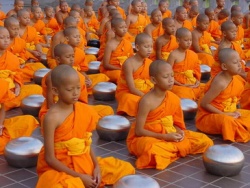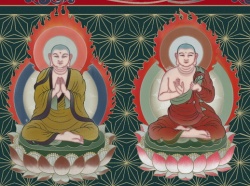Abhidhamma origins
Tradition[3] says that the Buddha thought the Abhidhamma out immediately after his enlightenment, but only taught it some years later, to the gods. He then repeated it to Sariputta, who handed it on to his disciples. This tradition is also evident in the Parivara, a very late addition to the Vinaya Pitaka[4], which mentions in a concluding verse of praise to the Buddha that this best of creatures, the lion, taught the three pitakas.[5].
Scholars however generally date the Abhidhamma works to around the third century BCE, 100 to 200 years after the death of the Buddha. Therefore the seven Abhidhamma works are generally claimed by scholars not to represent the words of the Buddha himself, but those of disciples and great scholars[6]. Dr Rupert Gethin however said that important elements of abhidhamma methodology probably go back to the Buddha's lifetime[7]. A. K. Warder and Dr Peter Harvey both suggested early dates for the matikas on which most of the Abidhamma books are based. Abhidhamma started out as elaboration of the suttas, but later developed independent doctrines[8].
As the last major division of the canon, the Abhidhamma Pitaka has had a checkered history. It was not accepted as canonical by the Mahasanghika school[1][9] and several other schools[10]. Another school included most of the Khuddaka Nikaya within the Abhidhamma Pitaka[1]. Also, the Pali version of the Abhidhamma is a strictly Theravada collection, and has little in common with the Abhidhamma works recognized by other Buddhist schools[11]. The various Abhidhamma philosophies of the various early schools have no agreement on doctrine[12] and belong to the period of 'Divided Buddhism'[12] (as opposed to Undivided Buddhism). The earliest texts of the Pali Canon have no mention of (the texts of) the Abhidhamma Pitaka[13]. The Abhidhamma is also not mentioned in some reports of the First Buddhist Council, which do mention the existence of the texts of the Vinaya and either the five Nikayas[14] or the four Agamas[15]. Other accounts do include the Abhidhamma.[16]
In the Theravadin Abhidhamma Pitaka, unlike the Abhidharma Pitaka of the Sarvastivada school, ontological theorizing is absent, and the question of ontological status of dhammas remains a moot point. The notion of sabhava (Sanskrit: svabhava) is only utilized in late Theravadin texts.[17] The doctrine of momentariness is also a late addition to Theravada thought.[18] It only appears at the time of Buddhaghosa.[19]
Buddhavacana
Theravada Buddhists accept that the Abhidhamma is a valuable and beneficial resource. But there is some debate as to whether it is Buddhavacana (the exact words of the Buddha) or not. Classical Theravada Buddhists see it as the word of Buddha described by the tradition of the Buddha ascending to the heavens to teach the devas and then Sariputta to the monks. Many Modern Theravada Buddhists also accept this account, whereas some are skeptical if it is exactly or completely Buddhavacana. Some feel that it represents great teachings, but authored by later disciples as more of a commentary, than the words of the Buddha as found in the Suttas and Vinaya.
Arguments that it may not be Buddhavacana include:
1. The Abhidhamma was not recited at the First Buddhist council.
2. The Abhidhamma was not recited at the Second Buddhist council and it was not until the Third Buddhist council before it was made official.
3. The story of the Buddha ascending to heaven to teach Abhidhamma is not in the Suttas.
4. The story of the Buddha ascending to heaven to teach Abhidhamma is not even in the Abhidhamma Pitaka, but rather in later commentaries.
5. It is not mentioned as one of the nine branches of the teachings (navanga, AN, II.103).
6. It contains information and a style not found in the Suttas and Vinaya.
Of the above arguments, number 6 is probably the weakest, because if it did not contain new information, what would be the use of it? If it just repeated what is already in the Suttas, we would have the three baskets of Suttas, Vinaya, and re-printing of the Suttas. So it is natural to expect the information to be different.
Arguments that it may be Buddhavacana include:
1. The term Abhidhamma is mentioned in the Suttas at various places.
2. It has the stamp of single mind.
3. Who but the Buddha could have fathomed the Abhidhamma.
4. There would have had to be a lengthy plot involving hundreds of monks actively lying and claiming that it was the Buddha Dhamma when it wasn't - and that is heavy kamma. I don't get that feeling about the ancient monks and nuns of Theravada. It is of course immaterial who taught it if we can apply it and see its truths.
5. The commentaries show that the Abhidhamma was recited at the First council and confirm the story of Buddha ascending to heaven to teach the Abhidhamma.
(arguments for Buddhavacana from: RobertK, Abhidhamma.org)
Of the above arguments, from a scholarly and historical position, number 5 is probably weakest because it is utilizing data hundreds of years after the fact to confirm events which are not recorded from those events.
Relying on the commentaries could be somewhat dubious. Ven. Dhammanando, Bhante has reported that, "the Atthakathā starts its explanation with the word kira, meaning something like "so it is said that,", "it is reported that...", or "rumour has it that..." The use of kira indicates that the commentator is non-committal about the factualness of what he is reporting; if you like, it's commentarial code for "take it with a pinch of salt" or "we don't insist that this is necessarily correct." (abhidhamma.org)
When discussing the use of the term Abhidhamma in the Suttas, Theravada translator, Bhikkhu Bodhi, has stated:
"Though the word cannot refer here to the Pitaka of that name obviously the product of a phase of Buddhist thought later than the Nikayas - it may well indicate a systematic and analytical approach to the doctrine that served as the original nucleus of the Abhidhamma Pitaka. In a careful study of the contexts in which the word 'Abhidhamma' occurs in the Sutta Pitakas of several early recensions, the Japanese Pali scholor Fumimaro Watanabe concludes that the Buddha's own disciples formed the conception of Abhidhamma as an elementary philosophical study that attempted to define, analyse, and classify dhammas and to explore their mutual relations." --MN trans. pg. 1225
In spite of the many arguments for and against the Abhidhamma as Buddhavacana or not, we can use Theravada Saddha (Faith) and personally study and test the principles and see if they are beneficial and match and are compatible with the Dhamma.



